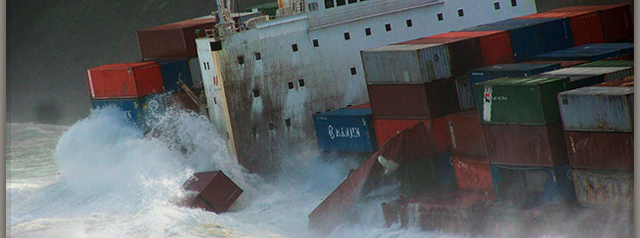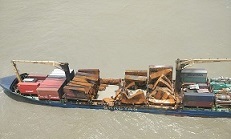Introduction
General Average (GA) is a broad and complex area. The aim of this paper is to give a brief overview of the subject, more detail is available on request.
History
In times gone by, merchants commonly used to travel with their goods on board the vessel. When the common maritime venture (consisting of both ship and cargo) got into difficulties, in some cases this could be cured by jettisoning some cargo. However there were understandable squabbles and delays over whose cargo should be thrown overboard. Obviously while this was decided, the common maritime adventure was in peril and could be lost.
The concept of General Average was developed in order to deal with this problem.
The first written law involving GA was found in Rhodian law (ancient Greek law) which “..decrees that if in order to lighten a ship, merchandise has been thrown overboard, that which has been given for all be replaced by the contribution of all”. This basic principle still holds true today – everybody who benefits from the sacrifice should contribute to the sacrifice pro-rata to the benefit.
It is important to note that at that time GA existed by force of law, independently of any incorporation into a contract of carriage.
Please also note the distinction between voluntary sacrifice and accidental damage – the former is within the scope of GA, the latter is not.
Development of York-Antwerp rules
Over time, different courts and jurisdictions had different interpretations of GA. Therefore, the industry saw the need for standardisation. Efforts were made to codify the principles of GA and refine the mechanics of calculating GA to avoid disputes. This would allow the parties to know where they would stand in a given scenario.
The first known attempt was in 1860, known as the Glasgow resolutions, and were followed in 1877 by the first York-Antwerp Rules (subsequently modified in 1924, 1950, 1974, 1994 and now 2004).
Over time, the York-Antwerp Rules (YAR) have been adopted into most contracts of carriage and apply as a contractual term. It is important to realise that if they are not incorporated into the contract of carriage, they will not apply and GA would be governed by the appropriate national law. It is also important to realise that there are many contracts of carriage that still incorporate old YAR either because they have not been updated or because the carriers feel there is advantage to them in retaining the old YAR.
Basic elements of a GA casualty
Rule A of the YAR provides-
There is a GA act when, and only when, any extraordinary sacrifice or expenditure is intentionally and reasonably made or incurred for the common safety for the purpose of preserving from peril the property involved in a common maritime adventure.
Therefore there are four elements that must be in place for GA to legitimately exist.
a)Sacrifice or expenditure. This must be extraordinary. Routine expenses which would have been incurred in the normal course of events are not part of GA.
b)The GA act must be intentional and reasonably made. The principle is that the act or expense should be deliberate. It cannot be accidental or an inevitability.
c)There must be peril. The peril should be real and significant. If there was a belief that there was peril, but in fact there was none, this will not be GA. The only exception to this is an engine breakdown in port. There is no peril, in that the ship could in theory sit there indefinitely, but market practice dictates that it is treated as such.
d)The act or sacrifice must be for the common safety in a common maritime adventure. If only one party benefits, or if the act was not for the common safety, it will not be a GA act.
Parties to GA
There must be more than one interested party to a GA. Only those who have an interest in property at the time of the casualty are parties to the GA. If your cargo is discharged before or loaded after the casualty, you will not be a party to the GA. Typically, the parties will be the shipowner, cargo owner(s), and sometimes the charterers will have bunkers on board.
It is important to note that any party to the venture can declare GA. Although usually in practice the shipowner is the party who declares GA, in some cases shipowners may not have an interest in declaring GA (because they may not want to contribute to sacrificed cargo) but cargo interests may wish to do so. An example of this could be a cargo fire which results in wet damaged cargo being sacrificed. The shipowner may be liable to contribute in GA to the sacrificed cargo, but by not declaring GA he may avoid doing so.
Typical procedure after a GA casualty (from cargo interests? perspective)
a) Declaration of GA
The Master will usually be the first to be aware of a casualty giving rise to a potential GA. He will then liaise with the shipowners and make a declaration of GA. Often this is formalised at the first port reached after the casualty by making a written declaration. The shipowners will usually appoint GA adjusters who are appointed by shipowners ?in the General Interest?. They in turn may appoint a General Interest surveyor to look at any damage to ship and/or cargo.
At this stage, if cargo interests have significant amounts at stake, they should also collect evidence and make their own enquiries into the cause of the incident.
b) GA Security
Shipowners have a posessory lien over the cargo for GA claims in most jurisdictions. In other words they can refuse to deliver cargo that is subject to a GA claim without receiving security for GA claims. Historically this used to be a cash deposit, but in later times these claims are secured by provision of paper guarantees.
Strictly speaking, since the GA claim is made against the owners of the cargo, then the cargo owners are the ones that should provide the security. In practice, the cargo owners tend to provide a GA bond guaranteeing payment, but this is usually only sufficient security when coupled with a guarantee of payment from a substantial company. In practice, this GA guarantee tends to be provided by underwriters, and very often signed by us on their behalf.
It is important to obtain advice on the form of the guarantee to ensure that additional liabilities are not being incurred. We do not charge for issuing such a non-personal guarantee on behalf of underwriters.
Once the security is accepted, the cargo can be released.
c) Contributory values
Since the parties to the common maritime adventure make contributions pro-rata to the values at risk – the “contributory values”, these need to be determined. These are taken to be the value of the goods at the discharge port, in other words the CIF value less any deductions that are made, for example for damage to the cargo. If there is sacrifice being claimed, the adjusters must be notified accordingly.
d) GA disbursements
The GA adjusters will collect details of the GA disbursements. These will be primarily from the shipowners but may be from other parties to the common maritime adventure.
e) Salvage
It is important to note that whilst salvage services may be involved in a GA casualty, the salvage and GA securities are independent of each other. The claim for salvage generally requires security to be provided direct to salvors and this is independent of any GA security required. We are well placed to assist with the provision of both types of security.
The only area of cross-over of salvage into GA will be the inclusion of amounts paid in salvage into GA as part of the expenditure incurred by the parties. This has been excluded for the YAR 2004, but will still be the case for previous YAR rules which are still in force in the majority of cases.
f) GA Adjustment
The adjustment will then be produced and the contributions of the various parties calculated. The general aim of the calculation exercise is to determine what the fair pro-rata contribution is from each party. Depending on the number of different interests and the complexity of the matter, it can take a year or more for the adjustment to be issued, and if there is salvage involved then it cannot be issued before the salvage claim is resolved, which in itself can easily take a year.
g) Defences
It is a common misconception that just because there is a claim for GA and an adjustment, that it is necessary to pay!
A review of the adjustment is necessary to ensure all the allowances are correct, and the contributory values are in order.
Furthermore, and most fundamentally, a claim for GA can successfully be defeated if the cause of the incident is unseaworthiness. The vast majority of GA cases are compromised or rejected. It is not necessary to pay the GA in the first instance and then seek recovery.
Incidentally, if cargo interests decline to pay GA, the shipowners can normally recover from their P&I insurers for cargo?s proportion of unpaid GA.
h) Recovery from third parties
In some cases, the GA may arise for reasons which the shipowner is not responsible for, or for which he has a contractual defence. In some of those cases, it may be necessary to settle the GA claim. However, it may be possible to make a recovery from a third party, for example a shipyard for making a negligent repair, or a colliding vessel bearing some blame for the collision.
It can also be the case that cargo interests that have made sacrifice will need to recover from other cargo interests and the shipowners. These parties may not pay voluntarily, and action may be needed to persuade them to settle.
Future development of GA
The 2004 YAR have been finalised. These are yet to be widely adopted, but the main points are that salvage payments will not now be re-adjusted in the GA, and the ships? wages and maintenance will not now form part of the GA. Generally speaking, there is a school of thought that believes that GA is on the decline and will eventually disappear. However given that it has been around for more than 2500 years and is still with us, it is with us for a while yet!
Casualty & GA Department








